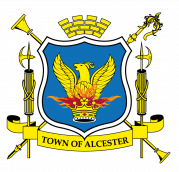In this section



History of Alcester
Alcester is an old market town of Roman origin at the junction of the River Alne and the River Arrow in Warwickshire, England. It is situated approximately 8 miles (13 km) west of Stratford-upon-Avon and 8 miles south of Redditch, close to the Worcestershire border.
In Roman times Alcester (Alauna) was a walled town and Roman fort of some importance being located at a junction between the Ryknild Street Roman road, the ancient Saltway from Droitwich, the Roman road from Stratford upon Avon and the Fosse Way.
The town today includes a number of preserved Tudor including the oldest inhabited Tudor house in Warwickshire. Other houses of historical note can be found near the parish church in Butter Street and in Malt Mill Lane. The Old Rectory, situated directly in front of the church, is a particularly interesting example of Georgian architecture. A number of fine Victorian additions have been made at the rear of the house. The clock on St Nicholas’ church is in an unusual position on the south-west corner of the 14th century tower, making it visible from the main High Street. The church also houses the tomb of Fulke Greville, grandfather of Fulke Greville, 1st Baron Brooke.
Alcester is known for two nearby local stately homes, Coughton Court, (a National Trust property) whose ancestors were key conspirators in the Gunpowder Plot of 1605 and Ragley Hall, which is the home of the Marquis of Hertford and houses the Jerwood Foundation’s sculpture collection. Kinwarton, which is just north of Alcester, contains a church of Anglo Saxon origin and a historic dovecote, Kinwarton Dovecote, which is a National Trust property.
Oversley Bridge
Please see the document below for the history of Oversley Bridge.
The Royal British Legion – Alcester Branch – Sacrifice and Service Books
We are excited to publish the website links to Alcester Royal British Legion’s online Sacrifice and Service books where you can turn the pages and search for names and places. These books contain information and stories about some of our local veterans and wartime events. We appreciate that there is so much more to tell and Alcester RBL welcomes new photos and articles that can be added in the future. Please contact David Malin if you have any questions or information that can be added. Please note that this is a ‘free to you trial’ and so you may see small adverts at the top and bottom of the screen. Do not click them.
The system hosting the books is best viewed on a large screen with the sound turned on so that you can hear the page turn sound. If you cannot hear the sound, it can be turned on in the menu or you may need to adjust the sound on your device.
On small screens such as iPads and mobile phones the text may appear small but it can be enlarged. There are options in the menu namely “view full screen” or “zoom in”.
The menu is accessible by clicking the three dots on the bottom right.
If the menu is not visible on small devices or you cannot see the three dots you can tap the screen to make it visible.
To turn pages please tap or click the screen or use the arrows on the left or right of the screen.
There is a search option in the menu so that you can find names or places. The results are highlighted in yellow.
A tribute to those from Alcester and Oversley who sacrificed so much for our freedom during the great war 1914 – 1918
Sacrifice and Service Stories Book
https://online.fliphtml5.com/vnopj/rwcz/#p=1
A tribute to those from Alcester and Oversley who sacrificed so much for our freedom during the second world war 1939 – 1945
Sacrifice and Service II Memorial Book
https://online.fliphtml5.com/vnopj/kqbq/#p=1
Sacrifice and Service II Stories Book
